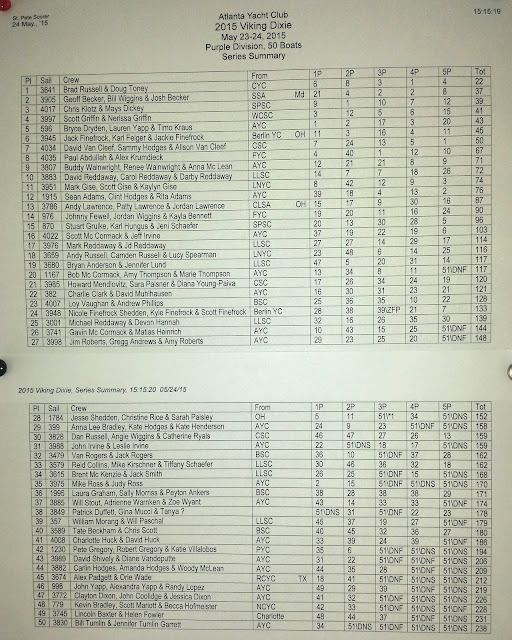This is a reprinted article from Sailing World. For the original article go here: http://www.sailingworld.com/how-to/boatspeed-jib-and-flow
Once, while coaching a team before the Rolex International Women’s Keelboat Championship, someone asked me about jib trim, so I hopped on board and sat to leeward to video their jib leech while the trimmer “clicked” in the jib. It was obvious right then and there just how sensitive jib trim is.
On a J/22, the cabin-top winch drum is small, and each click trims the jib only a fraction of an inch. As I filmed, the trimmer set the jib to her normal setting and observed the jib leech telltale flowing 100 percent of the time. She then trimmed in slowly, one click at a time, and it continued to flow until 10 clicks or so later, when it stalled. It happened instantly, as if the sound of the click itself caused the stall.
Because I typically steer I’m not used to looking at the jib leech telltale, but I do spend a lot of time looking at the mainsail leech telltale, which doesn’t behave at all in this way. The mainsail leech telltale starts to stall inconsistently, from 100 percent flying to 90 percent, then 80 percent, and so on as I trim in slowly. In contrast, this jib telltale seemed impossibly abrupt. So, with this same J/22 team we repeated the process a few times, and sure enough, it was either fully streaming or not all, nothing in-between.
 Properly Trimmed - A properly trimmed jib, visualized using smokelines in the wind tunnel, shows that the jib causes the air flow to bend through the slot and remain attached to the mainsail.
Properly Trimmed - A properly trimmed jib, visualized using smokelines in the wind tunnel, shows that the jib causes the air flow to bend through the slot and remain attached to the mainsail.Over Trimmed - When the leech telltale isn’t streaming, it’s a sure sign the jib is over trimmed, causing flow on the leeward side of the jib to separate.
In the wind tunnel, the over-trimmed jib shows how the slot is too narrow and the jib is trying to bend the flow too much. When the jib stalls, air on the leeward side is separated and disturbed, at times even flowing forward. This pulls the telltale to leeward and forward. The unsteady nature of the separation causes the telltale to jump around.
Under Trimmed - As shown in the wind tunnel, with an under-trimmed jib the slot is too open and the flow is not redirected behind the mast. Consequently, air flow becomes detached from the mainsail.
Before I move on to applying what I learned, I’ll share some language I use with my crew to describe various phases of trim.
“Max trim” is one click before the telltale stalls. I don’t like max trim because it’s too unforgiving. It’s too close to what is known as over trim, which is a disaster.
“Normal trim” is slightly eased from max trim. To find this more forgiving sheeting, we click in until it stalls (just past max), then ease again until it flows again. I find that there’s some hysteresis, meaning even though one click in makes it stall, we might ease the equivalent of six clicks before flow starts again. Then, to make it stall again it takes six clicks in and so on. In this example, normal trim would be about six clicks from stalling, but fortunately we don’t need to know that, we just need to over trim until it stalls, then ease until it flows again. Normal trim is our default setting. If it’s eased any further we’re giving up height by losing flow on the back of the main. If it’s trimmed in any further, it’s too close to stalling.
“Acceleration trim” is a bit eased from the normal trim—perhaps the same amount that normal is eased from max to normal. It’s more difficult to define because the leech telltale gives us no help in figuring it out. It will flow 100 percent at normal trim and will continue to do so as we let it out. The other problem in defining where this eased setting is that it may vary on how much we have to accelerate. If we are stopped, it will be more than if we just need to a small speed build, after a few small waves, for example. Either way, it really is not eased much. On a dinghy, the upper jib leech might be an inch further out. On a small one-design keelboat it might another 2 inches further outboard. This small amount at the upper leech often only requires a small ease of the jib sheet, so we’re careful not to have the jib out too far. Acceleration trim is more of a feel; we ease a little and feel the boat accelerate, then bring it back in slowly to normal trim as we get up to speed.
Reference points are extremely helpful, so during training and pre-race, we observe from leeward, watching the telltale and learning the range. Our trimmer and I then agree on the normal trim for the condition we’re sailing. We find a reference to recreate that trim without having to keep track of the leech telltale. Our trimmer likes a mark on the jib sheet for a very rough first pass.
The problem with a sheet mark is that a puff will open the leech and a lull will close it while the sheet doesn’t move at all. It is static while the leech is dynamic so it’s a poor fine-tune reference. Thus, for fine tune, we look for a reference close to the upper leech where we care the most. For example, on the J/22 we use the distance the jib leech overlaps the spreader. The J/24 has a genoa that sets outside the spreader tip, so we use the distance off the spreader tip.
On our Thistle we tape a zip tie on the middle spreader so the end is 10.5 inches from the mast. The trimmer can see this easily through a trim window in the main and trim by pulling the jib in to a repeatable distance from the end of the zip tie.
Marked measurement references are also useful. For example, on our J/24, we have pieces of tape at intervals of 2, 4, and 6 inches inboard from the spreader tip. Similar tape reference marks on the J/22 or Etchells spreader can directly be lined up with the leech of the jib since the leech is immediately in front and overlapping the spreader. For whatever boat we sail, we find and mark something near the upper leech that our eye can immediately and accurately repeat.
Every condition that varies from ideal usually requires an ease of the mainsheet, and therefore also requires a corresponding ease of the jib sheet. For example, when we are overpowered, we ease the main or drop the traveler to depower. In the opposite condition, light air, we ease the mainsheet and raise the traveler to open the leech of the main. If it’s wavy, we have to put the bow down to twist open the top of the main.
No matter what the reason, as soon as the mainsail starts to ease, the jib needs to match that ease to maintain flow. In each case, the same rules of thumb apply and we still do the same thing we do in ideal conditions; over trim the jib and then ease until the telltale flows. It will be more eased than flat water, but we still call this sweet spot normal trim for that condition.
I prefer to play the main more so than the jib, but I play them together whenever possible. For example, if our bow person says “bad wave,” I will ease the main and our jib trimmer will do the same. Then, as we get up to speed, we both slowly trim back to normal our trim. When overpowered, our bow will call “puff in 3-2-1, puff on” and we’ll both ease and then trim in when we feel under control again.
Tip: Leech Telltale Location
The leech telltale must be in the proper position in order to illustrate airflow across the sail. The sail will usually come with one, often attached at the end of the top batten. This sweet spot should be about three-quarters of the way up the jib, where, when we trim, the leech makes the most movement. Just above this telltale, the jib gets significantly smaller and the slot (the distance between mainsail and jib) narrows.
If it’s choppy and/or puffy I may have to play the main constantly, and it’s hard for the jib trimmer to keep up, so we keep the jib a little further out. The trimmer will set it more for trends than for every little change. In these conditions, it’s hard to communicate every change I make, so our trimmer listens to what I’m doing. For example, if he hears me uncleat, he knows I’m likely to be easing so he’s ready. When he hears my ratchet come in, he trims, too.
In breeze, he looks at the main backwind. Too much backwind or even worse, the main flogs a bit, he immediately eases. Too little backwind, he trims in to induce it. No matter the conditions, the more the main and jib are adjusted together to keep the best flow over both sails, the faster we will go.
When it’s very light, the jib sheet and clew patch weigh down the jib, so our trimmer sits to leeward and holds the clew up by hand while looking up at the leech.
The leech telltale doesn’t work equally well on all boats. It works best with a jib that has an upper batten and doesn’t overlap the spreader. We tried leech telltales on our J/24, which has a genoa, and they seem to behave differently than those on jibs. We seem to be able to trim beyond the point that the top telltale stalls and still be fast. The lesson here is that although trimming to the jib leech telltale is fundamentally sound and usually quite practical, we always speed test to confirm because there are exceptions.
Unless it’s light enough for the trimmer to sit to leeward, the jib telltale is hard to see. So we do our homework and experiment with different trims while training. Once we feel comfortable with the range of trim, we find solid, repeatable references for the over, max, normal, and acceleration trim settings in various conditions.
Don’t just blindly trim the jib and leave it though, we are proactive to match the mainsail when necessary and ensure flow across both sails. Speed testing is the only way to know for sure, but we find using the jib-leech telltale is an excellent and consistent indicator of good jib trim.
Basic Trim Modes in Brief
“Over trim”
When the leech telltale stalls (always slow, we never trim this hard).
“Max trim”
Just before the telltale stalls (it’s fast, but unforgiving, we rarely trim this hard).
“Normal trim”
Over trim until the telltale stalls, then ease until it flows again (that’s our sweet spot).
“Acceleration trim”
Eased the sails for temporary speed build (the leech telltale will be fully streaming.










